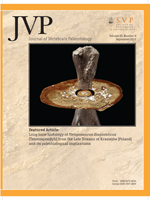A skull and a partial skeleton of a large late Pleistocene megalonychid sloth recovered from a cave on Cerro Pintado, Sierra de Perijá Mountain Range, a branch of the northern Andes, in Zulia State, Venezuela, is described as a new genus and species, Megistonyx oreobios. A cladistic analysis of the new taxon based on cranial characters indicates that it is closely related to Ahytherium, another late Pleistocene megalonychid from South America known from cranial remains, and suggests that there may have been at least two distinct clades within the family since the late Miocene. Megistonyx oreobios is one of a number of extinct sloth taxa found at high elevations in South America and suggests that many extinct sloth taxa were not as thermally sensitive as their modern relatives and were capable of living under colder climatic conditions.
How to translate text using browser tools
20 September 2012
A New Genus of Megalonychid Sloth (Mammalia, Xenarthra) from the Late Pleistocene (Lujanian) of Sierra De Perija, Zulia State, Venezuela
H. Gregory McDonald,
Ascanio D. Rincón,
Timothy J. Gaudin
ACCESS THE FULL ARTICLE





